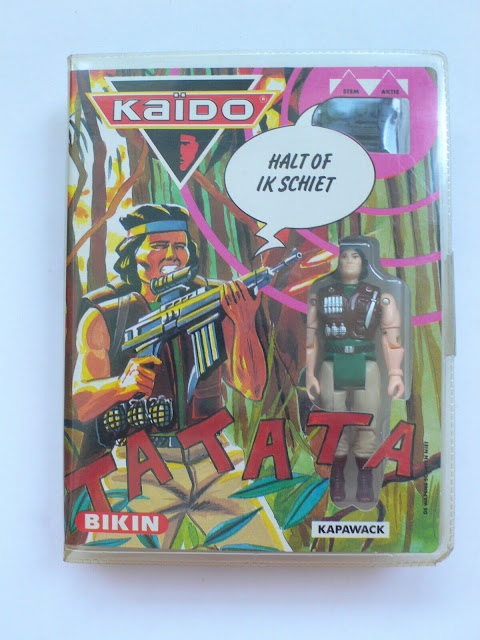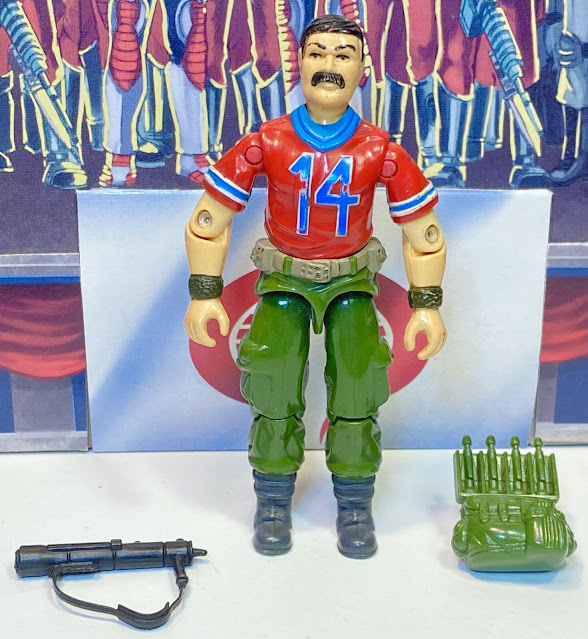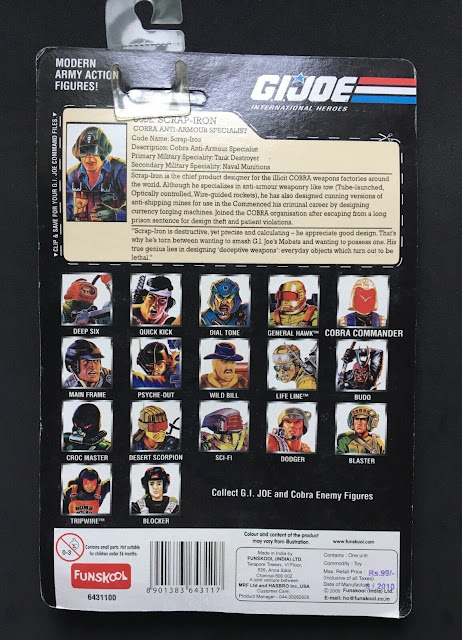Funskool stopped producing Joe figures in
2004. Sales had been slipping for a while. So, the line was cancelled even though Funskool had some additional new figures slated to appear later that year. However, in 2009, Funskool fired up the molds again in an attempt to cash in on the G.I. Joe movie. They re-introduced several figures from molds they still had in their possession. While there were no "new" figures produced, they did create several more minor variants of their existing paint schemes. On top of the oddball figure and accessory changes, each figure featured a new cardback with an explosion more akin to the pre-
1986 version on Hasbro cards.
These figures were not heavily imported to the US. Dealers didn't really bother with them as, at the time, most of the figures in the assortments were still pretty common. And, many US dealers were still dealing with overstock from their Funskool buys more than 5 years earlier. As there were no "new" figures in the assortment, there wasn't much incentive for anyone to really track them down. A few people did import some cases. And, those are the source of most of these figures today. In 2009, no on really thought that Trip Wire would become a $200 figure. But, the Funskool market of the 2020's has proven to have a short memory of what were once common and pegwarming figures.
The assortment that was released doesn't really have a theme beyond the molds that Funskool still had. We had a pretty good idea of which molds Funskool returned to Hasbro in 2003 just due to the last production run of bagged figures that Funskool ran. But, seeing Scrap Iron in here was a surprise. But, we've long known that the 2004 Hasbro Scrap Iron was a brand new sculpt. So, maybe his retention by Funskool shouldn't have been so unexpected.
The cardbacks were updated to show the new figures that were put into production. Some feature just 11 figures. While others feature 17. There are 18 total figures in the series. The one figure difference is because Funskool did not put the actual character who you were buying onto the cardback. So, Scrap Iron doesn't appear on the Scrap Iron cardback while Blaster does. But, on the Blaster cardback, Scrap Iron does appear but Blaster does not.
Desert Scorpion
Back in February of 2001, the Funskool Desert Scorpion was among the first cheap Funskool figures I ever bought. The Desert Scorpion is another figure that doesn't have many variants. It's also a figure that's gotten somewhat expensive in recent years. This later release doesn't appear to be materially different from the earlier figures, though. This figure features the 11 back card.
Budo:
Budo has a variety of subtle coloring variants. He also has an upper arm variant. You'll note the very dark hair on this version and that his upper arms do not have the red pockets.
Scrap Iron:
In 2004, it was somewhat assumed that Scrap Iron was returned to Funskool. However, when the 2004 Scrap Iron figure was released by Hasbro, it was obvious that they had made an all new mold for the character. Funskool kept the figure. Scrap Iron was among the first Funskool figures to appear in the 1990's. After he was taken out of production, he appeared again in 2002. Now, he's also appeared in the 2009/2010 timeline.
Blaster:
Blaster is one of the biggest and easiest variants to notice. The Roadblock machine gun has been removed and replaced with a black version of Mercer's rifle. It makes you wonder if Funskool returned the 1992 Roadblock gun mold to Hasbro when they returned the figure mold. And, if that's the case, it really makes you wonder why Hasbro didn't release it with either of the 1992 Roadblock repaints they released in 2004 and 2005.
Deep Six:
There's no obvious differences between this Deep Six and those made earlier. Surely, though, there are slight shading differences.
Dialtone:
The original Funskool Dialtone has an upper arm variant. There are color shading differences on his chest, too. As the Tunnel Rat mold was returned to Hasbro, this 2009 version features different upper arms than the most common early 2000's era figures.
Tripwire:
Tripwire is probably the most desirable figure from the 2009/2010 releases. While he was always interesting, the figure has taken on a spectacular aftermarket appreciation in recent years. This late version features the new explosion back but also has a variant filecard. The 2003 era figures have a more closely cropped picture of Tripwire on the filecard. The figure itself does have variations on the "Bomb Squad" text on his chest.
General Hawk:
There are many variants on General Hawk's red/orange highlights. So, it's likely these are different than the earlier releases. As General Hawk debuted in 2001, most of his figures tend to be of very poor quality and feature bad paint masks and construction issues. I do need to pick up one of these General Hawks and see if the quality is improved.
Mainframe:
Continuing the theme, Mainframe is pretty similar to his earlier releases. Funskool Mainframe's are one of the few figures that's not known for its variants. But, with just grey, black and silver, there's not a lot of color matching to create noticeable differences.
Wild Bill:
Wild Bill also debuted in 2001. And, there are two main variants as the figure can have either black or silver sunglasses. For the 2009 releases, all of them I've seen have featured the black glasses. This is another figure, though, I'd like to compare to my earlier samples to find any other changes.
Croc Master:
Croc Master features quite a few shading differences among his figures. It appears that the wrist guard on his right arm is a darker grey than earlier figures. And, his upper arms appear to be changed, too.
Cobra Commander:
The Funskool Cobra Commander figure never really got popular. That's likely due to the fact that the collectors who knew this mold as the character didn't really come of age until after the era of cheap Funskool was long over. The original Funskool figure isn't know for variants. And, this figure appears very similar to the original.
Sci Fi:
Sci Fi is known for his belt color variations. This version would have to be checked against the earlier figures. But, it's likely there's another variant in the later production run.
Lifeline:
Lifeline is another once common Funskool figure that has seen a sharp upturn in popularity and pricing in recent years. I'm not sure why. This version features yellow arms with a green chest. I got this same combo back in 2001. But, this 2009 version likely has color shading differences on his green plastic parts as well as the painted highlights.
Psyche Out:
The Funskool Psyche Out is great because it's an easy and still somewhat cheap way to get a complete version of this figure mold. The Hasbro version has gotten expensive. But, the Funskool has stayed affordable. Sadly, though, the figures made in the early 2000's are starting to badly discolor, even if they've been taken care of. Hopefully, the 2009 plastic is different.
Dodger:
The Funskool Dodger is fairly obscure. Even during the Funskool heyday, you didn't see him often. His face paint looks a bit different than the earlier figures.
Blocker:
Blocker doesn't appear all that different from his original release. His card art features a weird dart coming out of his gun with some bubbles around it. There are likely color shading differences between this figure and the earlier releases, though.
Quick Kick:
The Quick Kick mold has been around forever. And, the Funskool variants have a ton of sash and belt color variants.
There's the 18 figures that comprise the later run of Funskool figures. At this point, Funskool could still have these molds and make more figures in the future. Or, the molds could be gone. We're not sure. The fact that classic Joes didn't appear to coincide with the Snake Eyes movie in India, though, implies that there probably isn't a domestic market for these figures any longer. Though, I wouldn't mind if Hasbro got a couple of these molds back and put them into production. But, that will never, ever happen.







.jpg)
.jpg)
.jpg)
.jpg)




.jpg)

.jpg)
.jpg)

.jpg)


.jpg)

.jpg)
.jpg)
.jpg)
.jpg)














































